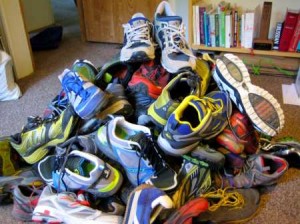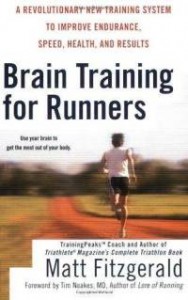You’ve got running questions. I’ve got running advice.
This article is a continuation of the Q&A style in the Strength Running PR Guide that I released earlier this year. The PR Guide is a Q&A style book with nearly 40 questions about running shoes, injuries, pacing, running gear, race tactics, and how to increase your endurance.
If you’d like access to the PR Guide, just sign up here. You’ll get full access to the Runner’s Gear Bag, including a circuit workout, premium content, and more resources to help you get faster.
These questions come from Sherry, who’d like some running advice about rotating her shoes and cross training.
Question #1 – Running Shoes
“In a recent training log, you mentioned that your running shoes are different brands. Is that a preference or should all runners be doing this? Is there a benefit to running in different brands of running shoe?“
This is a good question. First, a clarification: it’s not the brand that’s important but the type of shoe. Rotating different types of shoes will benefit you in several ways.
- You’ll allow your shoes to “recover” from daily running. The foam sole will last longer if you don’t run in them every day.
- Different shoes are constructed differently and have varying levels of support, cushioning, heel to toe drops (the difference in height between the heel and the toe), and overall feel. By stressing your feet in slightly different ways you’ll help avoid overuse injuries and ensure you’re strengthening different muscles.
- Lighter, more minimalist shoes can be used for shorter or faster runs to promote foot and lower leg strength, increased efficiency, and better form.
Runners should be training in at least two different types of shoes. Whether they are the same brand isn’t important; what’s critical is that they feel different and (preferably) one is slightly more minimalist.
Sometimes my feet or legs will feel stiff from regular training; a run in a different pair of trainers will help me feel better. I can’t definitively say that it’s from the change in shoes, but I think it helps to stress your body in slightly different ways.
You’ll often see elite runners rotating their shoes for most of their runs: they have shoes for races, workouts, long runs, and moderate distance runs. Each shoe has a different level of support and cushioning.
I’m currently training in the Saucony Kinvara and the New Balance MT101. Both are considered minimalist shoes but the Kinvara has ample cushioning that works well for most of my mileage. I use the MT101’s for very short runs or workouts where I’m running fast.
In the past I have trained in the ASICS Speedstars and the Adidas Adizero Mana’s – two of my favorite shoes. Both are less flexible than the Kinvara and the MT101 and provide less support than most traditional trainers. If you’re looking to transition to a more minimalist shoe but don’t know where to start, I highly recommend the Speedstar and the Kinvara.
Question #2 – Cross Training
“I’ve read a few marathon training plans and they all have a cross training day around the long run. Does it matter if you do it the day before a long run or the day after? Does it really matter when you do it?”
Cross training days should be used strategically to either promote recovery or get you ready for a hard effort (like a long run). It depends on your level of fitness and what type of race you’re training for.
If you are a fairly new runner or are not used to long runs or running 6-7 days per week, then it’s wise to use a day of cross training before your long run to get you ready to run long. The last thing you want is to be tired on the most important workout of the week.
You may also need a day of cross training after the long run if you need extra recovery. Cross training like cycling, swimming, or pool running can boost your aerobic fitness while promoting blood flow to your legs. Since these types of exercises won’t send any impact forces through your legs, you can still get in a good workout after a tiring effort on your long run day.
Ideally every runner would work up to the point of running 6-7 days per week and use cross training as a supplemental workout instead of a replacement workout (especially for marathoners). This isn’t always practical, so my second choice for most runners is to use it before a long run. Being properly prepared for a long run and then running it well is vital for marathon training.
Here is my ranking for those who want a cheat sheet of the best ways to use cross training around a long run:
- Run 7 days per week and use cross training like cycling or pool running as supplemental exercise to boost aerobic fitness and recovery.
- Run 6 days per week and cross train as your easy day, but not before or immediately after your long run.
- Run 4-6 days per week and cross train the day before your long run to rest and prepare your legs.
- Run 4-6 days per week and cross train the day after your long run to recover from the hard effort.
The reason that #4 is ranked last is because some research shows that slow running the day after a hard effort can help boost efficiency and fitness gains (even going REALLY slow!). I remember reading this study several months ago but unfortunately I can’t find it now. If you have it handy please let me know!

Scheduling your long runs, workouts, easy days, and cross training can be a daunting task. I’m glad that for the first eight years of my running career I had great coaches who planned my training for me. All I had to do was show up and get it done!
If you need help, let me know. Alternatively, you could follow a sample training plan from two guys I trust: Brad Hudson or Matt Fitzgerald. Check out Hudson’s book here or Fitzgerald’s book here. Coincidentally, Matt Fitzgerald is a co-author of Hudson’s Run Faster.
Thank you to Sherry for getting in touch and asking these great questions. Have a question of your own about running? Don’t be shy – email me at support@strengthrunning.com and I’ll write up a post or give you an answer directly.